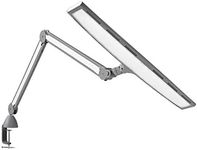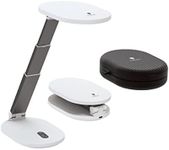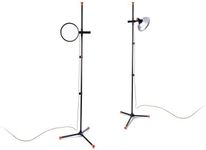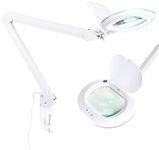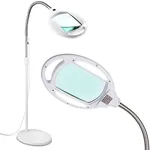Buying Guide for the Best Daylight Lamp For Artists
When choosing a daylight lamp for artists, it's important to consider how the lamp will affect your work environment and the quality of light it provides. A good daylight lamp can mimic natural sunlight, which is crucial for accurately seeing colors and details in your artwork. The right lamp can reduce eye strain and improve your overall working conditions, allowing you to focus on your creativity. Here are some key specifications to consider when selecting a daylight lamp for your artistic needs.Color TemperatureColor temperature is measured in Kelvin (K) and indicates the hue of the light source. For artists, a color temperature of around 5000K to 6500K is ideal as it closely resembles natural daylight, providing a neutral white light that helps in accurately perceiving colors. Lower temperatures (below 5000K) emit a warmer, yellowish light, while higher temperatures (above 6500K) produce a cooler, bluish light. Choose a lamp with a color temperature that best suits your working environment and the type of art you create.
Color Rendering Index (CRI)The Color Rendering Index (CRI) measures a light source's ability to reveal the true colors of objects compared to natural light. A CRI of 80 or above is generally good, but for artists, a CRI of 90 or higher is recommended to ensure that colors appear as accurate and vibrant as possible. This is particularly important for tasks that require color matching or detailed work. Consider your specific needs and the importance of color accuracy in your art when selecting a lamp with the appropriate CRI.
Brightness (Lumens)Brightness is measured in lumens and indicates the amount of light emitted by the lamp. For detailed art tasks, a higher lumen output is beneficial as it provides more illumination, reducing eye strain and allowing you to see fine details clearly. However, too much brightness can cause glare, so it's important to find a balance. Consider the size of your workspace and the type of art you create to determine the right level of brightness for your needs.
AdjustabilityAdjustability refers to the lamp's ability to be positioned and directed as needed. This includes features like adjustable arms, rotating heads, and dimmable settings. For artists, having a lamp that can be easily adjusted allows you to direct light exactly where you need it, which is crucial for different tasks and times of day. Think about your workspace layout and how you typically work to choose a lamp with the right level of adjustability for your artistic process.
Size and DesignThe size and design of the lamp can affect both its functionality and how it fits into your workspace. A larger lamp may provide more coverage, but it could also take up more space. Conversely, a compact lamp might be more convenient but offer less light. Consider the size of your workspace and your personal aesthetic preferences when selecting a lamp. The design should complement your work environment while providing the necessary functionality.




